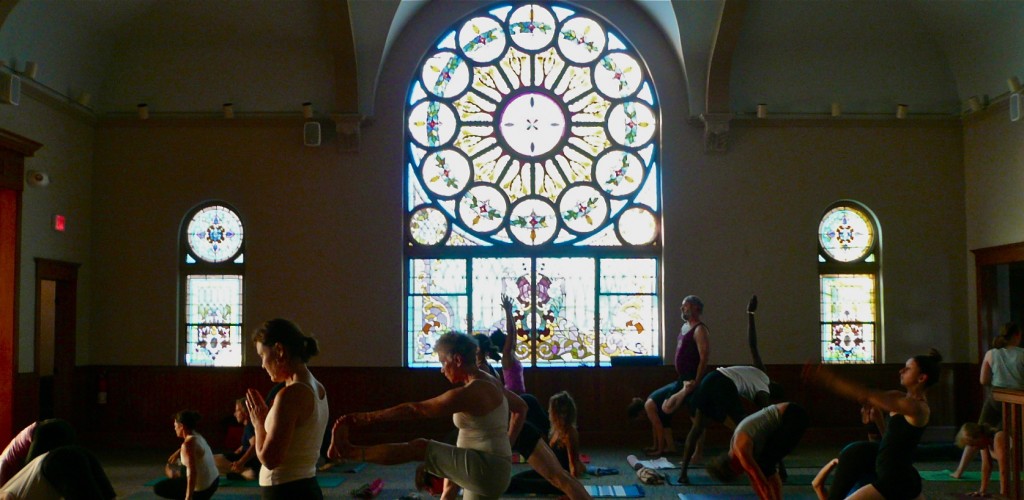Yoga 3.0. A retreat for an accelerated culture.
by Angela
WHEN.Â
January 13, 2013. 10-4. (Mysore practice 8-9:30.)
WHERE.
The Stone Arch, a decommissioned church in downtown Saline. (Pictured above.)
WHO.
Open now to all regular Mysore practitioners at AY:A2. Please join us! Retreat opens Dec 15 to anyone I know with a daily practice in the yoga tradition: drop a line now if you’re interested.
WHAT.
– Regular morning Mysore practice
– Break for drinks (Ashtangis take over the Drowsy Parrot… again!)
– A session on some subtle body or alignment principle of use to our group
– A short session on working with vrittis that arise during silent practice (this is a “reveal codes†talk – principles of traditional teaching method articulated!)
– Lunch by Gauri, who catered our 2011 retreats (“The two best meals I had this year were prepared by her†– Tim Veeser)
– Playful discussion of Yoga 3.0
– Gifts for all in attendance generously provided by Dead Sea Warehouse
TO PREPARE.
(1) Register by email, and pay.
(2) Read Chapter 3 of Yoga 2.0 by Remski and Petrie. $9 on Kindle, or borrow my copy.
(3)Â Mull over what Yoga 3.0 could be. What practical, political, technical, emotional, intellectual, activist, relational, devotional, or other qualities might equip us to create it?
PRICE:
– Full-time academic students: 45 (this is below cost – please do come, students)
– Retirees; Non-profit, industrial and service workers: 65
– Bourgeois Professionals (you might be bougeois if… you think you might be bourgeois): 85
– Support a student: 100
THEME.
In 2010, Remski and Petrie wrote: Yoga 1.0 is history. It is a book on a shelf, and perhaps a lecture talking about the book. Yoga 2.0 is a conversation. 2.0 invokes a move towards empowerment, interactivity, and relationship in its transmission. 2.0 shreds the illusory veils between east and west, and between past and present, between science and spirituality, and between yoga and any other form of intensive inquiry (p. 9).
This is an accurate, rousing description of post-modern yoga. It features not just consuming information, but talking back to it. It breaks old divisions like east/west and past/present. It is non-hierarchical and all-inclusive. For post-modernity, nothing is not yoga.
I would submit that, having encountered post-modern, commercial yoga some time since the 80s, each of you gradually developed a taste for something a little stronger. Yoga 3.0? You moved from being consumers (1.0), to commenters (2.0), and gradually became producers (3.0) of practice. You take your practice everywhere, and can create it under any conditions. This is not to say that any practice is yoga: you know quite well when you fall off your game. And while you are practicing an overtly egalitarian form (Pattabhi Jois said “anyone can do ashtanga, except lazy personâ€), there is an element of exclusivity in it. Taking action (showing up) does matter. Mastery is real.
Expertise accrues. The expertise you have after 3 years of daily practice is not just the same as that which you had after one year of practicing whatever you felt like just on the occasions you were in the mood. Unlike many post-moderns who mistake their own egoic attraction/revulsion reactions for their “inner teacher” and reject all other teachers because they trust no one, you are capable of being genuine and whole-hearted students. But, thank God (or, rather, thank post-modernity!) you’re way beyond the 70s-era illusion that surrender to what is (isvara pranidhana) is the same as abject submission to an inscrutable guru-authority.
In other words, you have a method, even if (again, thanks to post-modernity) you don’t think that method is perfect or timeless. But you do recognize that yoga has a factual, practical history rooted in India – yoga wasn’t made up in the last five minutes, cosmically speaking. Like Karl Marx, you study and embed yourself in history so as to be more powerful revolutionaries in the present.
When it comes to commercialism, Yoga 3.0 – being self-manufactured – is not marketable in the same way as is Yoga 2.0, which can be all things to all people. Yoga 2.0 is a brilliant grassroots movement, but, ironically, it is also highly amenable to commodification, buzz, and mass market appeal. But, bored by all that, you invest a different sort of energy in practice: your time, attention, and bodily participation. Practice has probably come to give you more energy than it takes, but this is only because you have invested quite deeply on the energetic dimension. That’s what is required to move far past consumption and spiritual materialism into the mindset of production.
Do bits of this sound at all familiar? Either way, I offer these fragments as raw beginnings for the post-post modern zeitgeist. Because I think you’re the ones who will make it happen.
Right now, as we hold our breath for the end of 2012, I suggest we start thinking about the foundation for the yoga that will burst forth after the collective exhale, and after the apocalypse that will never come. Lucky 13 is another turning of the wheel of yoga’s history. Let’s make it a strong revolution. I have no idea what it’ll look like, but I look forward to finding out together.
Space is limited. But not particularly exclusive! Drop me a line to inquire.
REFERENCES: the novel Generation X: Tales for an Accelerated Culture by Douglas Coupland. The 18th Brumaire of Louis Bonaparte by Karl Marx. You might be a redneck if… late 90s comedy routine by Jeff Foxworthy. Yoga 2.0 Mala 1: Shamanic Echoes by Matthew Remski and Scott Petrie.

Love the writing and will be there in spirit as I live too far to come along.
So wish I could join you, this is good stuff! xoxo
Really liked what you had to say in your post, Yoga 3.0. A retreat for an accelerated culture. : AY:A2, thanks for the good read!
— Gary
http://www.terrazoa.com